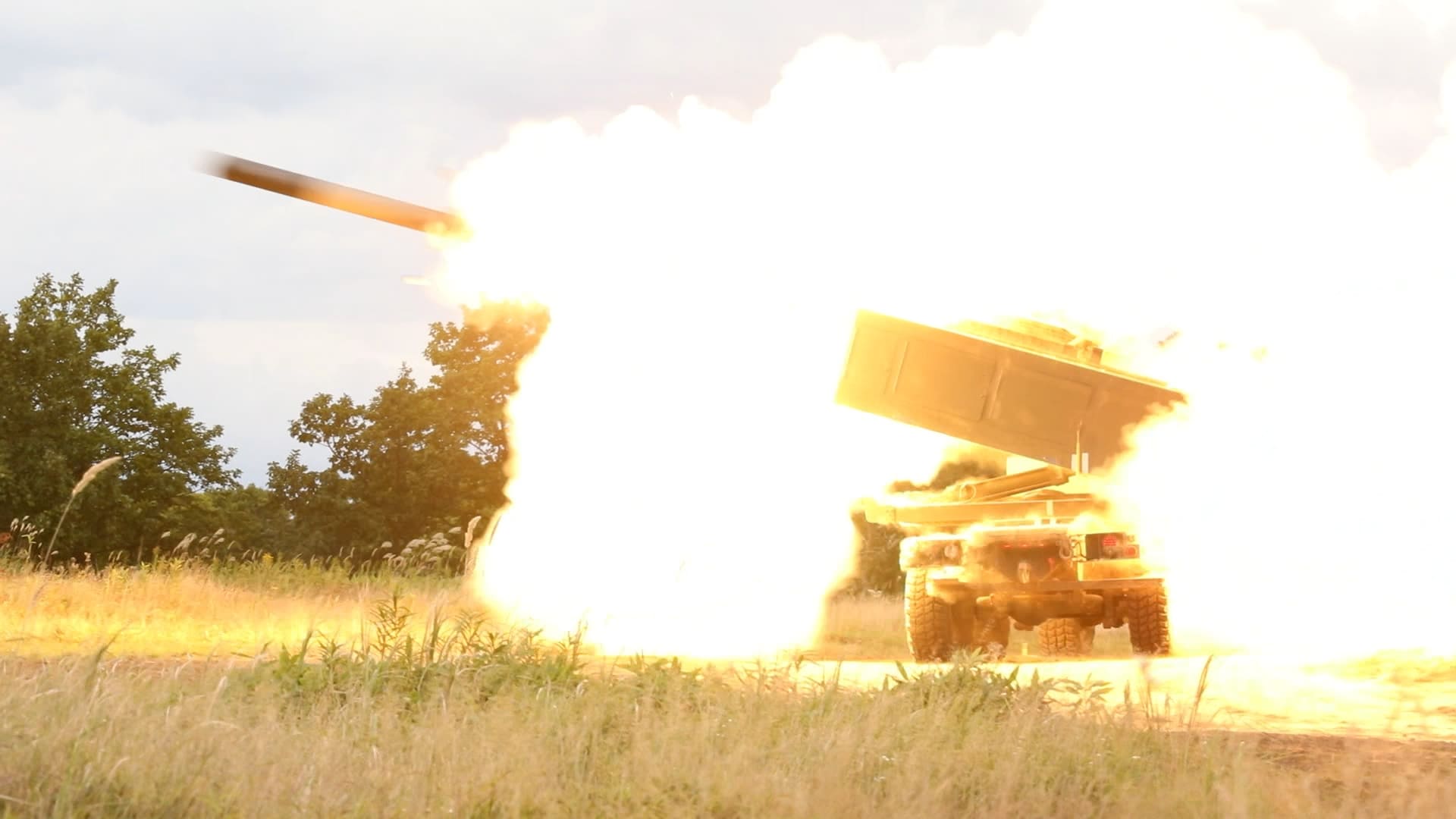The Army is moving fast to fold a new hypersonic strike option into its tactical fires family. This mirrors broader FY26 trends, including the FY 2026 Request: Space Force Seeks $277M for MILNET, which highlights cross-service efforts to fund next-gen networking and strike capabilities. Budget lines for fiscal year 2026 outline Project HX3, a pathway that funnels $25 million toward Castelion’s Blackbeard Ground Launch missile and an autonomous launcher called Common Autonomous Multi-Domain Launcher. Defense officials confirm the objective: prove a mature design in the first calendar quarter of 2026 and push ten flight-test rounds through a HIMARS rail before the fiscal year ends.
Blackbeard GL is a two-stage, solid-fueled round that aims for middle-weight hypersonic performance. It will not match the Army’s Long-Range Hypersonic Weapon in speed or range, yet, according to industry sources, it should deliver about eighty percent of the planned Precision Strike Missile Increment 4 reach at less than half the cost. Our analysis shows the service is trading peak velocity for affordability, faster production, and a launcher footprint that fits existing two-pod HIMARS launchers without redesign.
Castelion came to life in 2022 when former SpaceX staffers Bryon Hargis and Sean Pitt left the space sector and chose to chase Pentagon business. Their pitch: keep design cycles short, vertical-integrate the supply chain, and accept early risk through frequent hot-fires. The company machines its motor casings in-house, winds composite shrouds next door, prints control surfaces, and assembles seeker boards under one roof in southern California. Staff move quickly. Subscale motors ran within the first six months, and the team has stayed ahead of most government checkpoints.
Why does the Army care? Leaders need more shots per launcher, and they need them sooner. The existing Long-Range Hypersonic Weapon uses a giant, Navy-shared glide body and relies on a large trailer launcher. Each round costs well north of $40 million. That price and size keep the inventory small. Blackbeard GL, if numbers hold, should price in the single-digit millions and ride inside current recon platoons’ HIMARS fleet — making it an affordable hypersonic strike missile by design. Soldiers already trained on HIMARS would need only minor software updates and a new mission-planning screen. Recent evaluations suggest that Blackbeard GL poised to supercharge HIMARS by enhancing tactical flexibility at reduced cost. The Army sees this as a bridge to affordable hypersonic mass fires.
Documents filed with the Rapid Capabilities and Critical Technologies Office in May approved an urgent requirement for Blackbeard GL to meet HX3 objectives. The same packet assigned the new launcher effort, CAML, a medium and heavy branch. The medium variant will ride on a Family of Medium Tactical Vehicle chassis. It inherits the HIMARS pod rails and adds autonomy software that lets crews stage the vehicle, walk away, and control it over line-of-sight radio or satellite relay. The heavy configuration grows to a pallet that can fire Tomahawk or PAC-3-MSE rounds.
The test window runs January through March 2026 on the deep range at White Sands Missile Range. Castelion must deliver one proof-of-concept round plus a palletized fire-control package. If the missile survives boost and achieves stable glide, the company will earn a green light for Phase II. That phase orders ten minimum viable prototypes. All ten will fly from an Army-provisioned M142 HIMARS platform over desert canyon targets at ranges between 500 and 1,000 kilometers. Data will steer the Engineering and Manufacturing Development phase that follows.
The Army frames HX3 as a complement, not a replacement, for the ongoing Precision Strike Missile program. PrSM Increment 4 remains the service’s named solution for beating hardened, moving formations at strategic depth. Blackbeard fills a tier below, striking time-sensitive objectives such as air-defense radars, command vehicles, and bridge spans that appear inside the corps fight. Planners want at least a dozen ready rounds per fires battalion instead of a handful.
Early figures put Blackbeard’s all-up weight at roughly 2,000 pounds. Diameter stays under 17 inches, permitting two per pod. Launch motor burns for about twelve seconds, pushing the glide body past Mach 5. After stage separation, an aeroshell sheds, and the wedge-shaped body follows a depressed trajectory that holds altitude below the traditional ballistic arc. The profile complicates radar tracking and shortens detect-to-react cycles for point defenses. Guidance blends an inertial core with celestial updates and a multi-mode seeker for the terminal phase.
Schedule pressure drives Castelion’s build strategy. The firm prints flight-control fins on multi-laser powder-bed machines, heat-treats them in-house, and bolts assemblies without coatings. Avionics harnesses route through 3-D-printed support trays that double as internal stiffeners. Engineers say the approach chops ten weeks from classical supply lead times. If Phase I proves viable, full-rate additive lines could turn out eight rounds per month by late 2027, ahead of initial fielding in early fiscal 2028.
Army milestones locked to the HX3 effort:
- HX3 requirement approval: May 2025
- Phase I proof-of-concept delivery: December 2025
- First flight demonstration: February 2026 (target week 6)
- Phase II prototype lot contract award: April 2026
- Ten prototype launches complete: September 2026
- Engineering and Manufacturing Development start: Q1 FY27
- First unit equipped: Q1 FY28
Performance objectives for Blackbeard GL, based on draft requirements, include:
- Range: 500-1,100 km
- Cruise speed: Mach 5 to Mach 6
- Circular error probable: < 2 meters at 600 km
- Warhead: 220-pound unitary or penetrator kit
- Pod compatibility: existing HIMARS MFOM, new CAML medium pod
- Reload time: equal to standard GMLRS pod swap, under eight minutes
Army Comptroller tables show the project tapping the conventional missile and rocket line for $25 million in FY26 and a planned $120 million across FY27-29. Those numbers sit well below the $1.5 billion that funded LRHW to date. The deliberate gap supports Secretary of the Army Christine Wormuth’s instruction to pair exquisite hypersonic reach with a wider-scale solution that commanders can afford to fire.
Program managers admit risk. The glide body rides a sharp thermal gradient. A composite nose tip must live through upward of 2,400 degrees Celsius without ablation-induced wander. Castelion uses a siliconized carbon-carbon layup cured in a small autoclave once meant for rocket-engine nozzles. Institutions like Purdue’s hypersonics research facility support similar advances in high-temperature composite technologies. Manufacturing yield still hovers near 70 percent, a figure leaders want above 90 before rate production. The company has bankrolled extra layup tubes to work the problem outside Army funding.
Another risk stems from the new autonomy kit on CAML. The Army will field three prototype launcher vehicles in parallel with missile testing. Each unit receives LIDAR, stereo vision, and a hardened autonomy stack adapted from commercial self-driving trucks. Safety releases hinge on proving collision-avoidance logic in convoy and dispersed firing modes. If the software slips, Blackbeard can still flow to legacy HIMARS, but operational concepts built on empty-cockpit launchers would wait.
Castelion pushes an open interface at the fire-control layer. That decision lets the missile pull coordinates from Army Tactical Fire Control Systems, Marine Advanced Field Artillery Tactical Data Systems, or a joint gateway. Integration tasks remain, yet the framework avoids bespoke middleware. Defense officials confirm early bench tests with the Joint Fires Network passed the basic digital call-for-fire script last week.
Operational users care about the magazine. A single HIMARS truck carries two Blackbeard rounds per pod, four per truck. A battery of eight launchers could salvo thirty-two hypersonic shots, doubling the volume possible with current LRHW batteries. Logistic planners point out that a C-17 can haul four loaded HIMARS with missiles on board, something impossible with the heavier LRHW trailer. That mobility aligns with the Pacific posture plan that spreads forces among littoral islands.
Cost transparency remains a talking point. According to industry sources, Castelion quotes low-rate initial production at under $7 million per round. Traditional primes suggested higher figures. The Army withheld block-buy numbers until after Phase II results land. Congressional staff on the HASC emerging threats panel signaled support during a closed briefing Tuesday but warned the service to watch intellectual-property locks. They urged a tech-data package escrow to guard against vendor consolidation.
Army Futures Command views HX3 as a pilot for a new acquisition rhythm. Instead of the linear Technology Readiness Level ladder, leaders use an iterative spiral where test data flows directly into the next build. Service lawyers inserted contract language that allows option clauses every six months. If Castelion slips delivery or costs climb, the government can recompete or reassign to another mid-tier contractor. Analysts in the acquisition community see that clause as a lever to keep pace hot.
Industry peers watch closely. Two other startup shops, Antares Dynamics and Vector Launch Systems, recently pitched alternative mid-range hypersonic concepts. Both rely on liquid-fueled boosters and a common glide body that mount in new pods. The Army has not ruled out a follow-on competition after Blackbeard proves flight worthiness. Whether a broader portfolio emerges will depend on how well HX3 meets budget, schedule, and accuracy gates.
International partners ask if Foreign Military Sales might follow. Officials say Blackbeard GL stays inside the U.S. inventory through the first production block. Any export case would wait until technology security reviews finish. The missile’s guidance stack pulls from components already controlled under ITAR Category IV, so no new regulatory hurdles appear at first glance. Still, decision authority lies with the Defense Technology Security Administration, and the Army is not processing cases yet.
Troop training forms the next planning node. Fires Center of Excellence at Fort Sill drafted a new lesson plan covering pod prep, pre-launch alignment, and de-confliction of glide trajectories with airspace control orders. The course adds four training days to the existing HIMARS school, most of that for flight safety rules unique to hypersonic profiles. Units scheduled to receive the first missiles in FY28 will cycle through a pilot class in late 2027.
Sustainment looks straightforward. Blackbeard uses standard MLRS canisters with a desiccant pack and pressure seal. Shelf life goals stand at five years ambient, fifteen years conditioned. Depot artisans can swap the nose tip in theater if inspection flags micro-cracks after prolonged high-temperature storage. Castelion is building a depot line in Huntsville to keep repair turnaround inside CONUS.
Strategists weigh force-mix effects. A corps commander could hold Blackbeard GL in the same brigade support area as GMLRS while launching to ranges once reserved for theater assets. That reshapes sensor-to-shooter chains. The Marine Corps and the Navy are monitoring results, eyeing potential cross-domain launcher compatibility on unmanned surface vessels.
Castelion leadership stays focused on hitting the clock. “What matters is proof we can field at speed,” Hargis told a small group Tuesday. “The round wins on economics, not just physics.” Pitt echoed the point, noting that every week of delay eats margin in their financial model. Both men keep binder clips full of charts that track unit price against learning curves.
From the Army view, success will validate betting on emerging companies. If HX3 stays on track, the service could apply the same playbook to other munitions, cutting traditional development timelines by half. Congressional language in the FY26 mark backs that push, instructing the service to build measured experimentation while protecting core industrial capacity.
No program survives without setbacks. A subscale fin test tore at Mach 6 last month when a hinge pin walked loose. Engineers changed the alloy, added a lock wire, and repeated the run within nine days. That pace echoes SpaceX’s philosophy and remains foreign to many defense houses. Whether the model scales once the missile counts into the hundreds remains open.
With the test window only six months out, range coordination starts now. White Sands crews will clear altitudes across several corridors and coordinate with the FAA for boosted space. Each shot will carry a mid-course termination receiver and a passive destruct line in case telemetry drops. The Army must also align remote optical arrays to capture the thermal signature for data packs sent back to analysis labs.
Analysts argue that HX3 answers a specific gap. Commanders need a weapon faster than Tomahawk, cheaper than LRHW, and lighter than a ballistic missile. Blackbeard GL may be good enough if it hits accuracy marks. The final decision rides on flight data, production cost, and launcher autonomy. Until then, budgeteers hold funds in a fenced account, and Castelion runs its sprint.
The next few quarters will tell if a small shop can break through. A successful Phase I launch will move Blackbeard GL from concept talk to hard-data charts. A miss will push the Army back to the drawing board. Either way, HX3 shapes how the force thinks about hypersonic fires beyond boutique numbers.
REFERENCE SOURCES
- https://breakingdefense.com/2025/06/army-unveils-plans-to-acquire-two-different-sizes-of-autonomous-launchers/
- https://www.twz.com/land/blackbeard-cheap-hypersonic-strike-missile-being-developed-for-u-s-army
- https://defence-blog.com/us-army-eyes-hypersonic-missile-for-himars/
- https://interestingengineering.com/military/hypersonic-himars-us-army-missile-launcher
- https://caliber.az/en/post/us-army-bets-big-on-startup-led-hypersonic-weapon-for-tactical-edge
- https://breakingdefense.com/2025/07/army-eyes-new-program-test-with-castelions-blackbeard-hypersonic-missile-in-2026/
- https://defence-industry.eu/a-game-changer-blackbeard-gl-hypersonic-missile-poised-to-supercharge-u-s-armys-himars-by-2028/
- https://armyrecognition.com/news/army-news/2025/breaking-news-us-army-plans-to-give-himars-rocket-launcher-capability-to-fire-blackbeard-gl-hypersonic-missile
- https://news.ssbcrack.com/us-army-allocates-25-million-for-blackbeard-ground-launch-hypersonic-missile-development/



